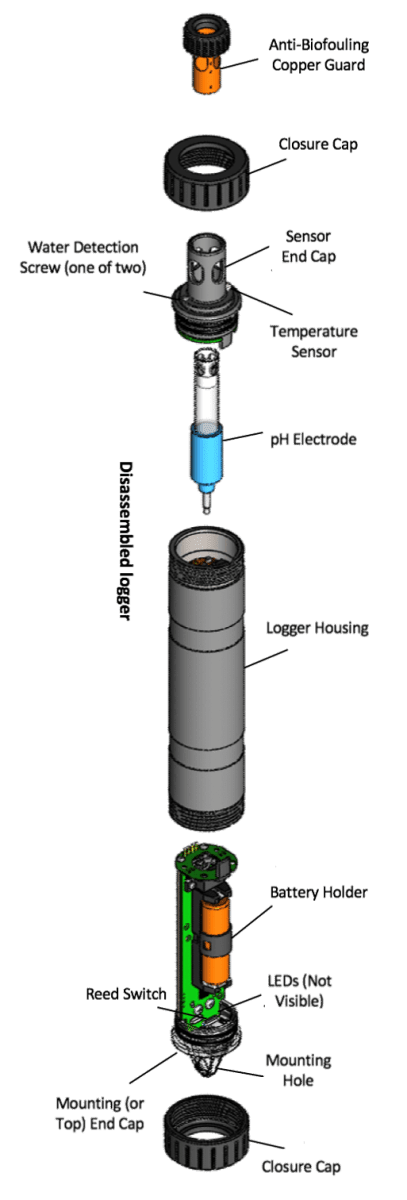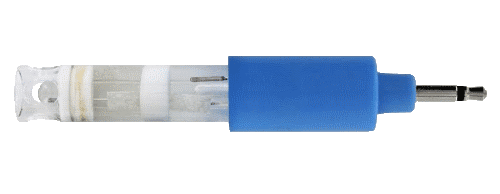- Home
- en
- datalogger-monitoring-systems
- hobo-products
- waterproof-mx2501
Logger for pH values and water temperature - HOBO MX2501
HOBO MX2501 pH data logger was developed for measuring pH and water temperature in bodies of water. It communicates wirelessly via Bluetooth Low Energy (BLE) with the HOBOmobile® app on your cell phone or tablet, making it quick and easy to set up, calibrate and retrieve data from loggers without the need for additional devices or complicated calibration procedures.
Robust measurement technology for reliable pH values
The MX2501 pH logger has a compact design and features a replaceable pH electrode, anti-biofouling copper protection and a PVC housing, making it ideal for freshwater or seawater environments. This means you can reliably measure the pH value and water temperature in both salt water and fresh water. Its robust design means it can withstand a wide range of underwater conditions, including large temperature fluctuations, strong currents and stormy oceans.
The battery-saving water detection function ensures a long battery life and the ability to take measurements over a longer period of time. When in contact with water, the Bluetooth function for transmitting pH and temperature values is deactivated.

Intuitive calibration and evaluation of measurement data
The HOBO MX2501 pH data logger requires the HOBOconnect app and a compatible mobile device. Use the HOBOconnect app to configure the data logger and easily read out the recorded values.
The integrated calibration function of the HOBOconnect app makes an otherwise difficult task a breeze and guides you seamlessly through the pH calibration process. Simply follow the on-screen instructions and your loggers' sensors will be precisely calibrated.
Specifications and technical data
pH data logger MX2501 - Measuring device for pH values and water temperature
| Measured values | pH, temperature |
| Temperature range | -2 °C to +50 °C |
| Buoyancy | Fresh water: 13.6 g negative Salt water: 19.6 g negative |
| Water resistance | up to 40 m |
| Battery life | 1 year at +25 °C, a recording interval of 1 minute and activated Bluetooth 2 years at +25 °C, a recording interval of 1 minute and Bluetooth deactivation on contact with water 3 years at +25 °C, a recording interval of 1 minute and Bluetooth deactivated Faster recording intervals and statistical sampling intervals, connection to the app, excessive downloads and paging can affect battery life. |
Temperature sensor
| Temperature range | -2 °C to +50 °C |
| Temperature accuracy |
±0.2 °C |
| Resolution |
0.024 °C at +25 °C |
| Response time | Approx. 7 minutes to 90 % in stirred water |
pH sensor
| pH | mV | |
| Measuring range pH |
2.00 to 12.00 pH |
-512 to 512 mV |
| Accuracy |
±0.10 pH units within ±10 °C of the temperature at calibration |
±0.20 mV |
| Resolution | 0.01 pH | 0.02 mV |
| Response time | 1 minute typical to 90 % at constant temperature in moving water |
HOBO MX2501 user-replaceable electrode
The electrode uses potentiometry and temperature measurements of samples to determine pH and can be easily replaced using the simple plug-and-play 3.5 mm connection. After proper calibration, storage and maintenance of the electrode, the MX2501 can achieve pH accuracies of ±0.10 pH units within ±10 °C of the temperature at calibration. The replacement pH electrode replaces the original one supplied with the HOBO MX2501 logger. This should be replaced after six months of use.
NOTE: pH electrodes should always be stored in storage solution when not in use.
Frequently asked questions
- +
Can I download data from an MX2501 pH logger that is used in water?
No, the logger must be removed from the water to download the data. - +
Does the logger have a user-replaceable electrode?
Yes. - +
What type of pH electrode is used?
Plastic-filled double junction electrode with Pellon® junction and gel reference electrolyte. - +
Can I calibrate with custom pH buffers?
No. The electrode is calibrated to 2 or 3 points using standard pH buffers (4, 7 and 10). - +
Is the calibration procedure the same for freshwater and seawater applications?
The procedure itself is the same; however, some users who use the loggers in salt water may wish to use a modified version of the pH buffers that contains chemicals (e.g. Tris buffer) to make the hydrogen ion activity in the buffer more similar to their activity in salt water.
pH loggers - important factors for selection
Data logger for measuring the pH value
Monitoring pH values plays an important role in industry and environmental monitoring. If a pH data logger is used for this purpose, it provides information about long-term trends and conclusions about the effects of various factors. Before you measure the pH value with a data logger, you should consider three things that can affect the measurement accuracy.
Basics of pH measurement
The pH value represents the hydrogen ion activity of a solution. The pH scale varies from 0 (strongly acidic with a high concentration of H+ ions) to 14 (strongly alkaline with a high concentration of OH- ions). The most common pH measurement method uses a special hydrogen ion-selective electrode (pH probe) immersed in the solution together with a second reference electrode. This ion-selective electrode provides a voltage output relative to the reference electrode that varies with the concentration ratio of hydrogen ions inside the electrode to those outside the electrode. The output of the reference electrode is independent of the ion ratio. By measuring the voltage between these two electrodes, you can determine the pH value of the solution. However, measuring the pH of a solution is not as simple as it may first appear.
3 Considerations for accurate pH measurements
Using a simple voltage input data logger to record the potential between the two electrodes presents several challenges that must be considered in order to obtain accurate pH measurements:
- The voltage range of a standard pH sensor is in the range of +400 mV to -400 mV, which corresponds to a pH range of 0 to 14 at room temperature. Any data logger intended for pH measurements must be able to record positive and negative voltages. In addition, the device must be sensitive enough to accurately measure small changes in voltage. A data logger that provides a full input range of ±1 to 2 volts will ensure adequate accuracy and resolution to detect changes in pH of 0.1 or less - a logger designed for a full range of 10 volts may not provide the required accuracy.
- The pH electrode has a very high impedance, the pH electrode generates a voltage, but because this voltage develops across an ion-selective glass membrane, the amount of current the electrode supplies to the measurement circuit is very small. A standard voltage data logger can have an input impedance of 1 megohm, which is sufficient for typical voltage measurements. However, when measuring pH, the amount of current drawn through this resistor leads to loading effects that result in large errors in the measured voltage. It is very important to choose a data logger with a high impedance input amplifier, typically in the order of 1 gigohm or higher, to allow direct measurement at the pH electrode with negligible current draw. If this is not possible, pH measurements can be made with standard voltage data loggers using an external preamplifier or a pH probe with an internal amplifier to provide a buffered output signal and avoid negative effects of the input load. The most common amplifier is a small battery-powered unit that only provides buffering without voltage amplification. Since the currents are very small, these amplifiers can run for months on a single battery. Other amplifiers are also available that can be operated with an external DC power supply to ensure continuous operation over a longer period of time. If the data logger and pH electrode are to be far apart, it is best to use an amplifier with a current output of 4-20 mA. This allows the signal to be transmitted hundreds of meters with very little loss of accuracy or increased noise.
- The final consideration in pH measurement is the effect of temperature on the output voltage of the sensor. The error in the output voltage worsens as you move away from a pH of 7 and the temperature deviates from 25°C. For example, without taking temperature into account, simply measuring the voltage output of a probe immersed in a solution with a pH of 2 at a temperature of 85 °C can lead to errors up to a pH of .9. In this case, choosing a multi-channel data logger that can handle both temperature and voltage provides the ability to measure and correct for temperature.
Conclusion for choosing a pH logger
There are 3 important factors to consider before purchasing a pH data logger for your application:
- The small, bipolar output voltage of the standard pH sensor
- The effect of the input impedance load of the data logger on measurement accuracy
- The need to consider the effect of temperature on the output of the pH sensor





